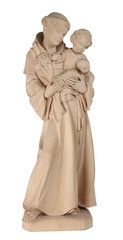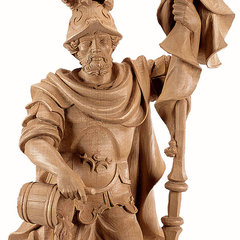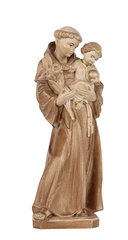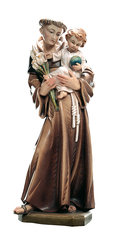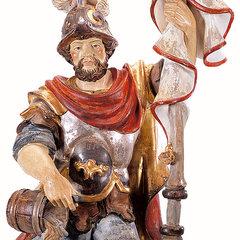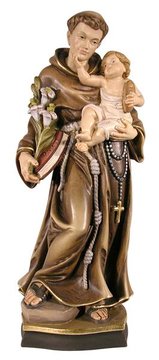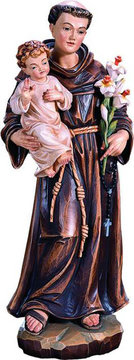
St. Anthony of Padua
Art. K06900
€ 110,00
$ 109,88
Pricelist
| cm | inch | natural | stained | stained 3 col. | color | real gold |
|---|---|---|---|---|---|---|
| 12 | 4,72 |
-
|
-
|
-
|
-
|
-
|
| 20 | 7,87 |
-
|
-
|
-
|
-
|
-
|
| 30 | 11,81 |
-
|
-
|
-
|
-
|
-
|
| 36 | 14,17 |
-
|
-
|
-
|
-
|
-
|
| 40 | 15,75 |
-
|
-
|
-
|
-
|
-
|
| 60 | 23,62 |
-
|
-
|
-
|
-
|
-
|
| 80 | 31,50 |
-
|
-
|
-
|
-
|
-
|
all prices are VAT included
Description
Without any further explanation, Saint Anthony is supposed to be Saint Antony of Padua or Saint Anthony the Great.
Commemoration day:
Saint Anthony of Padua: 13th June
Saint Anthony the Great: 17th January
Anthony of Padua was son of a very rich family of the nobility. After his ordination to the priesthood, he was named guestmaster and placed in charge of hospitality for the abbey. It was in this capacity, that he came into contact with five Franciscan friars who were on their way to Morocco to preach the Gospel to the Muslims there. Anthony then set out for Morocco, in fulfilment of his new vocation. Illness, however, stopped him on his journey. At this point, he decided to head to Italy. On the voyage there, his ship was driven by a storm onto the coast of Sicily and he landed at Messina. From Sicily he made his way to Assisi and finally to Bologna. There he appears to have lived as a hermit. Anthony died in Padua on 13 June 1231 at the Poor Clare monastery at Arcella.
Anthony the Great was born in Coma to wealthy landowner parents. When he was about 18 years old, his parents died and left him with the care of his unmarried sister. Shortly thereafter, he decided to give away some of the family estate to his neighbors, sold the remaining property, donated the funds thus raised to the poor and became the disciple of a local hermit.[3]
Anthony is notable for being one of the first ascetics to attempt living in the desert proper, completely cut off from civilization. The devil fought St. Anthony by afflicting him with boredom, laziness, and the phantoms of women, which he overcame by the power of prayer, providing a theme for Christian art. Though Anthony himself did not organize or create a monastery, a community grew around him based on his example of living an ascetic and isolated life.
Without any further explanation, Saint Anthony is supposed to be Saint Antony of Padua or Saint Anthony the Great.
Commemoration day:
Saint Anthony of Padua: 13th June
Saint Anthony the Great: 17th January
Anthony of Padua was son of a very rich family of the nobility. After his ordination to the priesthood, he was named guestmaster and placed in charge of hospitality for the abbey. It was in this capacity, that he came into contact with five Franciscan friars who were on their way to Morocco to preach the Gospel to the Muslims there. Anthony then set out for Morocco, in fulfilment of his new vocation. Illness, however, stopped him on his journey. At this point, he decided to head to Italy. On the voyage there, his ship was driven by a storm onto the coast of Sicily and he landed at Messina. From Sicily he made his way to Assisi and finally to Bologna. There he appears to have lived as a hermit. Anthony died in Padua on 13 June 1231 at the Poor Clare monastery at Arcella.
Anthony the Great was born in Coma to wealthy landowner parents. When he was about 18 years old, his parents died and left him with the care of his unmarried sister. Shortly thereafter, he decided to give away some of the family estate to his neighbors, sold the remaining property, donated the funds thus raised to the poor and became the disciple of a local hermit.[3]
Anthony is notable for being one of the first ascetics to attempt living in the desert proper, completely cut off from civilization. The devil fought St. Anthony by afflicting him with boredom, laziness, and the phantoms of women, which he overcame by the power of prayer, providing a theme for Christian art. Though Anthony himself did not organize or create a monastery, a community grew around him based on his example of living an ascetic and isolated life.
Variants
 natural
Natural wood not treated
natural
Natural wood not treated
 stained
Stained and treated with pastel paints
stained
Stained and treated with pastel paints
 stained 3 col.
Stained with at least 3 shades of color and treated with pastel paints
stained 3 col.
Stained with at least 3 shades of color and treated with pastel paints
 color
Colored with oil paints and gilded with gold leaf
color
Colored with oil paints and gilded with gold leaf
 real gold
Colored with acrylic colors on a chalk background and gilded with 18 carat gold
real gold
Colored with acrylic colors on a chalk background and gilded with 18 carat gold
Available versions and sizes:
